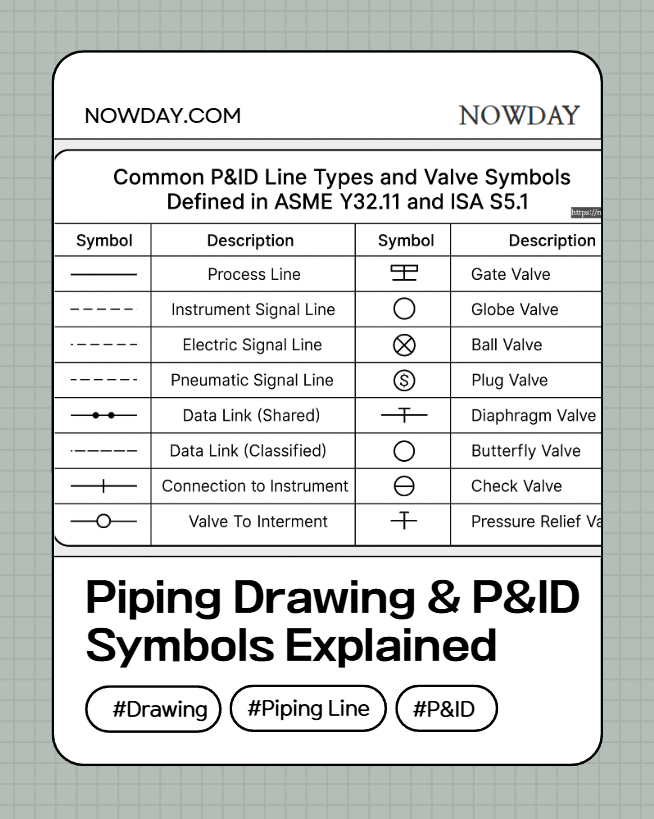
1. Introduction
In every plant or industrial facility, piping drawings are the foundation of communication between design, fabrication, and operation teams.
These drawings use standardized symbols to represent pipes, valves, instruments, and equipment — a visual language understood across all engineering disciplines.
This guide summarizes the most common piping and P&ID symbols, helping you interpret and create process diagrams accurately.
2. Basic Piping Drawing Types

| Drawing Type | Description | Used In |
| PFD (Process Flow Diagram) | Shows overall process flow, major equipment, and key control loops. | Conceptual design |
| P&ID (Piping and Instrumentation Diagram) | Detailed layout of pipelines, valves, instruments, and connections. | Detailed design, operation |
| Isometric Drawing | 3D representation showing actual pipe routing, elevation, and dimensions. | Fabrication, installation |
3. Common Piping Line Symbols

| Symbol | Description | Example |
| ─── | Process Line (General) | Main process flow |
| -.-.- | Pneumatic Line | Instrument air |
| === | Electrical Signal | Transmitter wiring |
| ---/--- | Hydraulic Line | Hydraulic actuator control |
| ⎯⎯⎯(insulation mark) | Insulated Line | Steam or chilled water |
Tip: Line thickness often indicates pressure level or importance — main lines are bolder, branch lines thinner.
4. Valve Symbols (Quick Reference)
| Symbol | Type | Notes |
| ⊗ | Gate Valve | Isolation, full open/close |
| ⊖ | Globe Valve | Throttling, moderate control |
| ▭ | Ball Valve | Quick shutoff |
| ⊕ | Check Valve | Prevents backflow |
| ◉ | Pressure Relief Valve | Safety release |
Reference: ASME Y32.11 / ISA S5.1 standards.

5. Instrumentation & Control Symbols
| Symbol | Description | Function |
| ○ | Field instrument | Local measurement |
| ◑ | Controller | PID control device |
| ⊙ | Transmitter | Sends signal to DCS |
| ▽ | Indicator | Display only |
| ⧫ | Alarm | Warning or trip condition |
Instrumentation symbols usually include tags like PT-101 (Pressure Transmitter) or FCV-201 (Flow Control Valve).
6. Equipment Symbols
| Symbol | Equipment | Common Use |
| ⊗⊗ | Pump | Fluid transfer |
| □ | Tank or Vessel | Storage or reaction |
| △ | Heat Exchanger | Cooling or heating process |
| ⦿ | Compressor | Gas compression |
| ⌂ | Reactor | Chemical process |
These are simplified 2D shapes — actual equipment drawings appear in isometric or GA (General Arrangement) drawings.
7. P&ID Tag Numbering Convention
Example tag breakdown:
PT-101A
| Part | Meaning |
| P | Pressure |
| T | Transmitter |
| 101 | Loop number |
| A | Suffix (redundant or parallel unit) |
Consistent tagging ensures traceability across drawings, control systems, and maintenance logs.
8. Practical Tips for Reading P&IDs
- Start from main process flow, then trace branch lines.
- Identify control loops (valves + transmitters + indicators).
- Check for instrument air and electrical signal lines — they often indicate automation.
- Look for bypass lines (manual operation paths).
- Always verify equipment tag numbers match the master datasheet.
9. Conclusion
Piping and P&ID symbols form the visual grammar of industrial engineering.
Once you understand the symbols, you can read any plant drawing with confidence — from chemical reactors to semiconductor utilities.
Whether you’re a design engineer, operator, or student, mastering these symbols is the first step to reading real-world process documents fluently.
Flange Types and Their Applications – Weld Neck, Slip-On, Blind, Socket Weld, Threaded, Lap Joint
Flanges may look simple, but each type has a specific role in how a piping system handles pressure, temperature, and vibration. Using the wrong flange type can lead to leaks, misalignment, or even catastrophic failure.This guide explains the most common fl
www.nowdaylab.com
Flange Standards & Dimension Chart – ASME / JIS / DIN Comparison
1. ANSI / ASME B16.5 – Class 150 (RF Type)(Reference: ASME B16.5-2020)2. JIS B2220 – 10K Flange Dimensions(Reference: JIS B2220-2019)3. DIN EN 1092-1 – PN16 Flange Dimensions(Reference: DIN EN 1092-1:2018)7. Size Conversion (ASME / JIS / DIN) ASME (i
www.nowdaylab.com
Flange Standards and Dimensions – ASME, JIS, and DIN Compared
1. IntroductionFlanges connect everything — pipes, valves, filters, vessels — but people rarely look at the standard behind the bolt circle. Let’s break down how ASME, JIS, and DIN flanges differ in size, pressure class, and application.2. Major Flan
www.nowdaylab.com
What Is a Pressure Vessel? Field Notes on Design, Types, and Safety Codes
IntroductionAsk anyone who’s spent a few years around plants —a pressure vessel isn’t just a big metal tank.It’s the heart of any process line. When one goes wrong, you’re not just stopping production; you’re flirting with disaster.These vessel
www.nowdaylab.com


